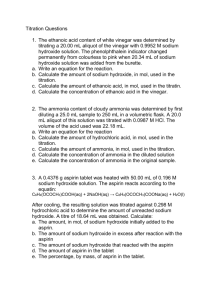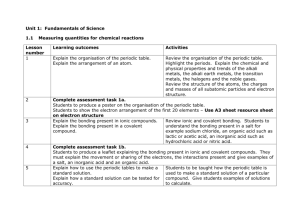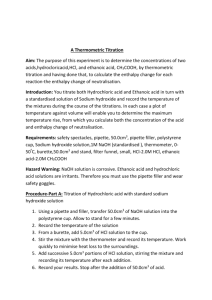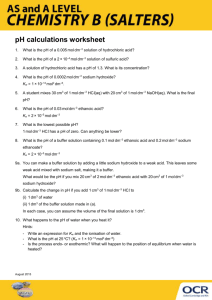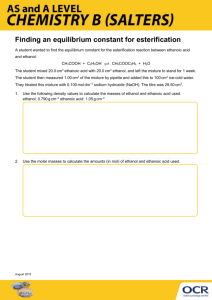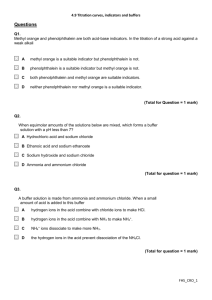File
advertisement
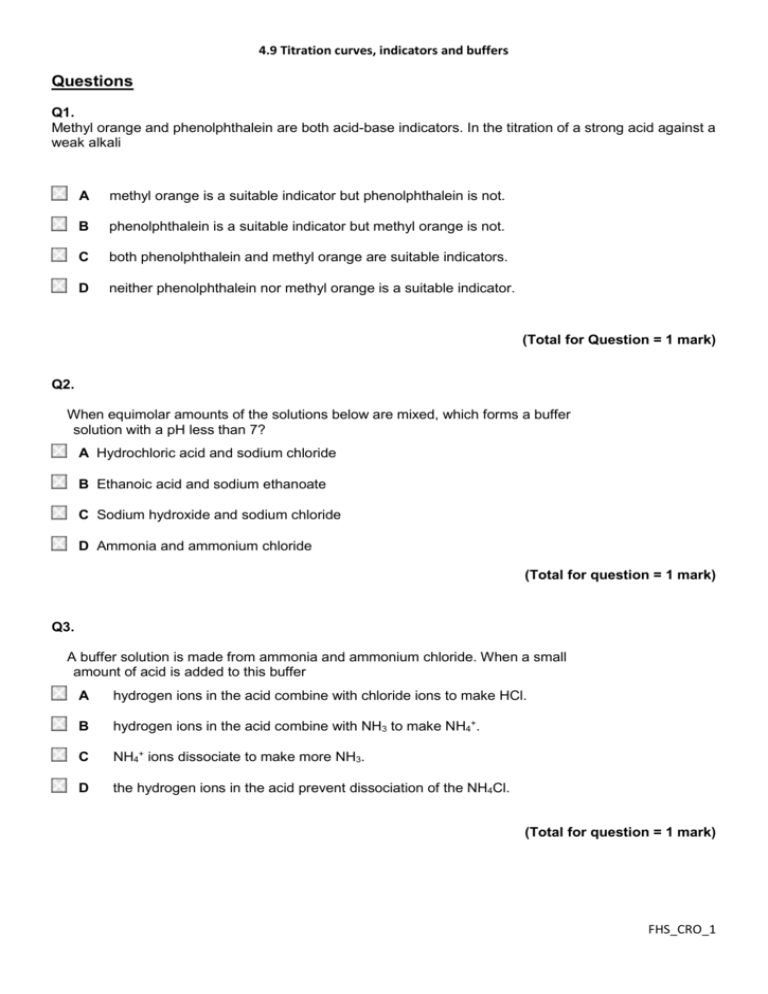
4.9 Titration curves, indicators and buffers Questions Q1. Methyl orange and phenolphthalein are both acid-base indicators. In the titration of a strong acid against a weak alkali A methyl orange is a suitable indicator but phenolphthalein is not. B phenolphthalein is a suitable indicator but methyl orange is not. C both phenolphthalein and methyl orange are suitable indicators. D neither phenolphthalein nor methyl orange is a suitable indicator. (Total for Question = 1 mark) Q2. When equimolar amounts of the solutions below are mixed, which forms a buffer solution with a pH less than 7? A Hydrochloric acid and sodium chloride B Ethanoic acid and sodium ethanoate C Sodium hydroxide and sodium chloride D Ammonia and ammonium chloride (Total for question = 1 mark) Q3. A buffer solution is made from ammonia and ammonium chloride. When a small amount of acid is added to this buffer A hydrogen ions in the acid combine with chloride ions to make HCl. B hydrogen ions in the acid combine with NH3 to make NH4+. C NH4+ ions dissociate to make more NH3. D the hydrogen ions in the acid prevent dissociation of the NH4Cl. (Total for question = 1 mark) FHS_CRO_1 4.9 Titration curves, indicators and buffers Q4. Which of the following mixtures would form the best buffer solution with pH 9 for use in a school laboratory? A Ethanoic acid and sodium ethanoate B Sodium chloride and sodium hydroxide C Hydrocyanic acid and sodium cyanide D Ammonium chloride and ammonia (Total for question = 1 mark) Q5. Which of the following mixtures would form the best buffer solution with pH 5 for use in a school laboratory? A Ethanoic acid and sodium ethanoate B Hydrochloric acid and sodium chloride C Sodium hydroxide and sodium methanoate D Ammonium chloride and ammonia (Total for question = 1 mark) Q6. Which one of the following indicators is most suitable for titrating ethanoic acid with 0.1 mol dm −3 sodium hydroxide? (Refer to page 19 of your data booklet.) A B C D Thymol blue (acid) Bromothymol blue Thymol blue (base) Alizarin yellow R (Total for question = 1 mark) FHS_CRO_2 4.9 Titration curves, indicators and buffers Q7. In a pH titration, 30 cm3 fo sodium hydroxide solution was added, in 1 cm3 portions, to 20 cm3 of ethanoic acid solution, CH3COOH(aq). The concentration of both solutions was 0.50 mol dm−3. After the addition of each 1 cm3, the pH was recorded using a pH meter. (a) (i) Write the Ka expression for ethanoic acid. (1) (ii) Using your answer to (i), calculate the pH of the 0.50 mol dm−3 ethanoic acid solution before the titration starts. Refer to page 18 of the data booklet. (2) (iii) Deduce the volume of sodium hydroxide solution required to reach the end point. (1) ............................................................................................................................................. (iv) Calculate the pH of the solution after all of the sodium hydroxide is added. (4) FHS_CRO_3 4.9 Titration curves, indicators and buffers (v) On the axes below sketch a graph to show how the pH changes during the titration. (3) FHS_CRO_4 4.9 Titration curves, indicators and buffers (b) An acidic buffer solution can be made by mixing together a solution of ethanoic acid and solid sodium ethanoate. (i) Calculate the mass of solid sodium ethanoate (molar mass = 82 g mol−1) that would be added to 500 cm3 of ethanoic acid, concentration 1.0 mol dm−3, in order to make a buffer solution of pH = 4.70. (4) *(ii) Explain how this buffer solution resists a change in pH when a few drops of sodium hydroxide are added. (3) ............................................................................................................................................. ............................................................................................................................................. ............................................................................................................................................. ............................................................................................................................................. ............................................................................................................................................. ............................................................................................................................................. (Total for question = 18 marks) FHS_CRO_5 4.9 Titration curves, indicators and buffers Q8. The bubble bath 'Colour Change Matey' has amongst its ingredients the weak acid benzoic acid, as well as the indicator bromocresol green. When it is added to bath water, its colour changes from yellow to blue. (a) (i) Write the Ka expression for the dissociation of benzoic acid, C6H5COOH. (1) (ii) Use the data on page 18 of the data booklet to calculate the pH of a solution of benzoic acid, C6H5COOH, of concentration 0.0025 mol dm−3. (2) *(b) Use the data on page 19 of the data booklet, and your answer to (a)(ii), to suggest why the bubble bath changes colour when it is diluted by being added to the bath water. (4) ............................................................................................................................................. ............................................................................................................................................. ............................................................................................................................................. ............................................................................................................................................. ............................................................................................................................................. ............................................................................................................................................. ............................................................................................................................................. ............................................................................................................................................. (Total for question = 7 marks) FHS_CRO_6 4.9 Titration curves, indicators and buffers Q9. The titration curves below were obtained using different acids and bases, each with concentration 0.1 mol dm−3. (a) Which curve is produced by adding ammonia to 25 cm3 of hydrochloric acid? (1) A B C D (b) Which curve is produced by adding ethanoic acid to 25 cm3 of sodium hydroxide? (1) A B C D (c) An indicator with pKIn 8.5 is suitable for the following titrations. (1) A Titrations A and B only. B Titrations A, B and D only. C Titration C only. FHS_CRO_7 4.9 Titration curves, indicators and buffers D Titrations A, B, C and D. (Total for question = 3 marks) Q10. Vinegar is used as a food preservative. It is an acidic solution containing ethanoic acid, CH3COOH. (a) A titration was carried out to measure the concentration of ethanoic acid in a sample of vinegar. 25.0 cm3 of a vinegar solution was titrated with a solution of sodium hydroxide, concentration 0.250 mol dm−3. The concentration of the ethanoic acid in the vinegar solution was found to be 0.125 mol dm−3. (i) Calculate the pH of 0.250 mol dm−3 sodium hydroxide at 298 K. [Kw = 1.00 × 10−14 mol2dm−6 at 298 K.] (2) (ii) Write the expression for the acid dissociation constant, Ka, for ethanoic acid. (1) (iii) Calculate the pH of 0.125 mol dm−3 ethanoic acid at 298 K. [Ka for ethanoic acid is 1.7 × 10−5 mol dm−3 at 298 K.] (2) (iv) When half the ethanoic acid is neutralized, the concentration of the remaining ethanoic acid equals the concentration of the sodium ethanoate which has formed. What is the pH of the mixture at this point? Justify your answer. (2) pH ............................................................................................................................................. Justification ............................................................................................................................................. FHS_CRO_8 4.9 Titration curves, indicators and buffers (v) On the axes below, sketch the titration curve for this reaction when 30 cm3 of the sodium hydroxide is added to 25.0 cm3 of the vinegar solution. (3) *(vi) The only indicators which were available for this titration were methyl yellow (in ethanol) and thymolphthalein. Explain which indicator is more suitable for this titration and why the other is unsuitable. You will need to refer to your data booklet. (2) ............................................................................................................................................. ............................................................................................................................................. ............................................................................................................................................. ............................................................................................................................................. ............................................................................................................................................. (b) In the food industry, ethanoic acid is described as an acidity regulator, additive number E260. Ethanoic acid can neutralize alkalis. What substance could be mixed with ethanoic acid so that it regulates pH as a buffer in foodstuffs? (1) ............................................................................................................................................. (Total for question = 13 marks) FHS_CRO_9 4.9 Titration curves, indicators and buffers FHS_CRO_10
